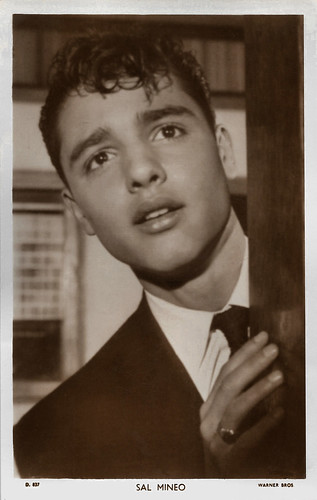
British postcard in the Picturegoer Series, London, no. D. 837. Photo: Warner Bros. Sal Mineo in Rebel Without a Cause (Nicholas Ray, 1955).

Belgian postcard by E.D.U.G., no. 172. Ricky Nelson.

Dutch postcard by Uitg. Takken, Utrecht, no. AX 3978. Photo: Paramount. Elvis Presley and Carolyn Jones in King Creole (Michael Curtiz, 1958).
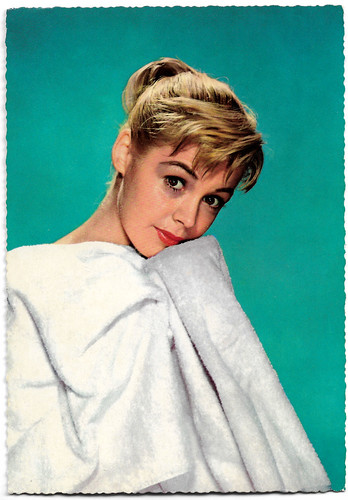
West-German postcard by Krüger, no. 902/9. Photo: Terb Agency. Sandra Dee in Gidget (Paul Wendkos, 1959).
Against the corrupting influence of Rock and Roll
Post-war teens were able to buy relatively inexpensive phonographs — including portable models that could be carried to friends' houses — and the new 45-rpm singles. Rock and Roll music of artists like Elvis Presley, Chuck Berry, Jerry Lee Lewis, Buddy Holly, and Fats Domino, played on 45s became the soundtrack to the 1950s as people bought what they heard on the radio. Rock and Roll had evolved from Rhythm and Blues, a sound developed by African-American musicians that by the early 1950s had slowly begun to reach a new audience in young white teenagers. By nature of its association with blackness, many white American adults feared that Rock and Roll was a corrupting influence on their children, promoting socialising between races, juvenile delinquency, and even premarital sex.
Music was not the only thing that disturbed conservative grown-ups. In August 1957, pioneer Rock and Roll disc jockey Alan Freed’s WABC-TV teen dance show Big Beat was cancelled after African-American artist Frankie Lymon was seen dancing with a white girl on the program. Less than a year later, at the Boston date of his Big Beat Spring 1958 tour, Freed was charged with anarchy and inciting the youths in attendance to riot, though the charges were later dropped.
Parents worried about their kids' attraction to artists who were edgy and rebellious. So the industry took control and created new teen idols. New faces in magazines fed fans; fans bought records, saw films, watched TV and bought fashions. In all of these media, the new formula consisted of selling products associated with photogenic, well-mannered young people to teenage consumers.
The ingredients of a teen idol recording included an attractive usually white, conservatively attired, and well-groomed young media star singing simple lyrics about typically middle-class teen concerns. Some marketers turned to film and TV for fresh, attractive, 'safe' faces. Ricky Nelson, a performer of rockabilly music, became a teen idol through his parents' television series, The Adventures of Ozzie and Harriet. With many parents disapproving of Elvis Presley, Nelson became a safe alternative. Another young TV star who was hustled into a studio to make recordings was ex-Mousketeer Annette Funicello who became one of the first big female idols.
Marketing of the teen idol generally focused on the image. The teen idol was structured to appeal to t young female pop audience members. They were commodified in forms and images that are relatively non-threatening to this young audience and to the ancillary market of parents. The process had the implicit blessing of parents and other authority figures given the alternative; that American youth would fall under the influence of more rebellious cultural icons, including juvenile delinquents feared to inhabit the street corners of every 1950s town and, of course, Rock and Roll stars. An unspoken compromise between the teen desire for an energetic rock beat and the establishment’s need for convention was achieved.

Spanish postcard by Archivo Bermejo, no. C-94, 1963. Photo: 20th Century Fox. Frankie Avalon on the set of Voyage to the Bottom of the Sea (Irwin Allen, 1961).

Italian postcard by Rotalfoto, no. 923. Sent by mail in 1963. American singer and actor Fabian Forte (1943) a.k.a. Fabian.
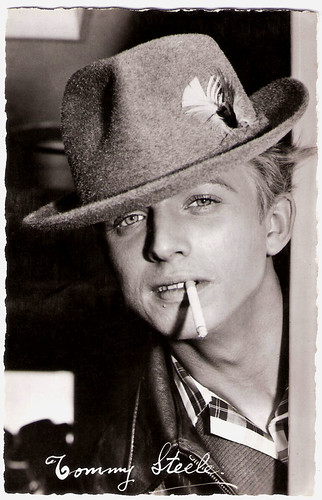
Vintage postcard. Tommy Steele.

Dutch postcard, no. 6357. Sent by mail in the Netherlands in 1965. Helen Shapiro meets a German teen idol, Peter Kraus.
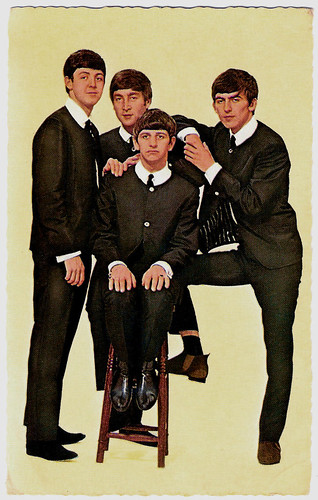
Vintage postcard. The Beatles.
Great Britain: The idol maker and his stable of stars
Teen idols such as Ricky Nelson, Bobby Rydell, Bobby Darin, Paul Anka, Frankie Avalon, Fabian Forte, and Pat Boone seemed to be the kind of earnest young men any father would be happy to have his own daughter go out on a date with, and Annette Funicello and Sandra Dee were the young women a son would aspire to marry. Their clean-cut good looks meant that they would play well on television, which was rapidly replacing the radio as the main source of family entertainment.
The teen idols were enormously popular. Attracting huge crowds wherever they went, their records proceeded to climb to the top of the Rock charts. Naturally, since armies of teenage girls wanted to touch them, legions of teenage boys tried to imitate them. Given the fact that many teen idols couldn't really sing, the sugary pop arrangements exhibiting a mere trace of the big beat took on even greater importance.
The fact that many of the singers were already stars on TV or in the cinema (including Sal Mineo and Tab Hunter) virtually assured the success of promotional efforts on the part of the record labels. In the late 1950s, teen idols were often given roles in films, supporting older male stars to attract a younger audience. Ricky Nelson starred opposite John Wayne in the Western Rio Bravo (Howard Hawks, 1964) and Frankie Avalon appeared with Alan Ladd in the Western Guns of the Timberland (Robert D. Webb, 1960). In the 1960s, Avalon increasingly turned to the cinema and teamed up with Annette Funicello in a series of popular beach movies.
Teen idols usually appear in magazines aimed at teenagers. Stories of teen idols literally discovered on their front porches (Fabian Forte) abounded in fan publications. In the 1950s, teen idols had to keep their romance(s) and marriage(s) secret or risk losing popularity. If the combined forces of the industry (label promotion, trade ads, and exposure on both radio playlists and American Bandstand) were marshalled on behalf of a young performer, anything was possible. The formula consistently worked from the late 1950s up to the mid-1960s.
A similar – if more cynical – approach to the teenage market was being employed in Great Britain, where showbiz impresario Larry Parnes employed good-looking young male singers on a weekly wage, before marketing them heavily to exploit their looks and talent. 'The idol maker' had a 'stable of stars', each of whom he gave a new identity – Ron Wycherley became Billy Fury; Reg Smith was christened Marty Wilde. Parnes not only gave each singer a new moniker, but he also managed their public appearance, ensuring each boy’s haircut was slicked up high and that they knew how to present themselves to have mass appeal. Similarly, Tommy Steele, Cliff Richard, and Helen Shapiro became 'idols of the young', particularly at the very beginning of their careers.
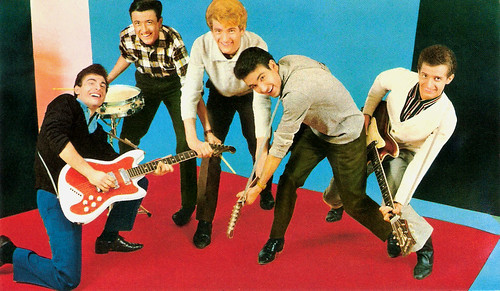
French postcard by E.D.U.G., no. 250, offered by Corvisart. Photo: Roland Carré. Eddy Mitchell and Les Chausettes Noires.
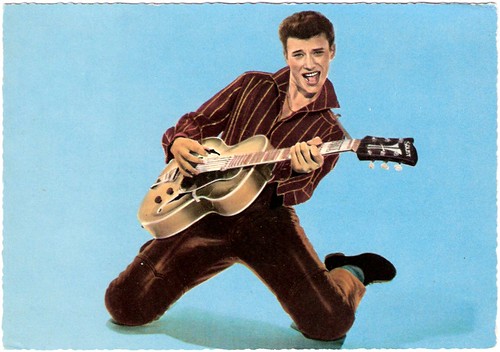
German postcard by ISV, no. H 85. Johnny Hallyday.

French postcard by E.D.U.G., no. 276. Offered by André. Photo: Sam Lévin. Sylvie Vartan.

French postcard by Publistar, no. 858. Photo: Spitzer / Disques Vogue. Françoise Hardy.
Beatlemania and the yé-yé movement
In the early 1960s, the reigning teen idols soon found themselves outclassed by a new phenomenon. By following in Larry Parnes’ footsteps, manager Brian Epstein was able to sell his protégées, The Beatles. He put them in smart suits, had them present themselves cleanly and politely, and made them appeal to a family audience. The Beatles soon became the most successful and influential band in modern musical history. Adolescent hysteria was so loud that the band had trouble performing at concerts.
Also in the US, The Beatles created a sensation. The band stayed at the top of the Billboard charts for a grand total of 58 weeks between 1964 and 1970. The level of stardom they achieved in the U.S. — dubbed 'Beatlemania' — was never before seen in that country, not even during the heyday of Elvis Presley.
The Beatles, and also The Rolling Stones were definitively teen idols, especially during the earlier part of their careers, although they quickly grew out of that status. The Rolling Stones did it through a more rebellious image, the Beatles did it through their more adult music. The great majority of the music being marketed to 1950s teens was written by adults, but 1960s teens were increasingly appreciating and emulating artists closer to their own age, to teen fashion, and to lyrics that addressed their own concerns.
In France emerged the Yé-yé in the early 1960s. Yé-yé was a particular form of the counterculture that derived most of its inspiration from British and American Rock and Roll with elements of pop, jazz, and the French chanson. The style expanded worldwide as a result of the success of French teen idols such as Johnny Hallyday, Sylvie Vartan, and Françoise Hardy. Influenced by Elvis Presley and the 1950s Rock and Roll revolution, Johnny Hallyday and such groups as Les Chats Sauvages and Les Chaussures Noires started to sing Rock and Roll in French. Their music topped almost every European chart, but
The yé-yé movement had its origins in the radio program 'Salut les copains' (Hello mates), created by Jean Frydman and hosted by Daniel Filipacchi and Frank Ténot, which first aired in December 1959. The program became an immediate success, and one of its sections, 'Le chouchou de la semaine' (This Week's Sweetheart), became the starting point for most yé-yé singers. Any song that was presented as a chouchou went straight to the top places in the charts. The Salut les copains phenomenon continued with a magazine of the same name that was first published in 1962 in France, with German, Spanish, and Italian editions following shortly afterwards.

Dutch postcard by Hercules, Haarlem, no. 279. Photo: Hafbofilm. Sabine Sinjen and Corny Collins in Schmutziger Engel/Imperfect Angel (Alfred Vohrer, 1958).

German postcard by Hans Josef Rüdel, Filmpostkartenverlag, Hamburg-Bergedorf, no. 2647. Photo: H.P. / Union / Haenchen. Conny Froboess, Rex Gildo, Richard Hellmann, Elke Arendt, Monika Leonhardt, Sergio Casmai and Hans Zander in Hula-Hopp, Conny (Heinz Paul, 1959).
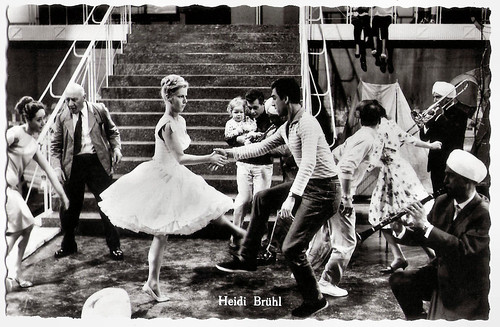
Dutch postcard by N.V. v.h. Weenenk & Snel, Baarn, no. 761. Photo: Gofilex. Heidi Brühl in Immer will ich dich gehören/Always I Will Be Yours (Arno Assmann, 1960).

Dutch postcard by N.V. v.h. Weenenk & Snel, Baarn. Sent by mail in 1961. Conny Froboess holds copies of several of her films.
Greaser riots in Germany
In the late 1950s, American Rock and Roll became popular in (West) Germany. There was a new subculture of adolescents – mostly male and of working-class parents – that appeared in public aggressively and provocatively. They were called 'Halbstarke' (literally half-strengths", loosely 'greasers'). These Halbstarken often wore a quiff, jeans, checked shirts, and leather jackets. They had found prototypes for their fashion and style in American films, e.g. in Rebel Without a Cause (Nicholas Ray, 1955) as well as the stars of Rock and Roll.
In 1956 Karin Baal and Horst Buchholz became idols thanks to the film Die Halbstarken/Teenage Wolfpack (Georg Tressler, 1956). That same year Bill Haley & His Comets' song 'Rock Around The Clock' reached #1 in the German Pop charts. On 30 December 1956, about 4000 juveniles walked through Dortmund city, affronting passers-by, rampaging, and having battles with the police, after a cinema screening of Rock Around the Clock (Fred F. Sears, 1956) with Bill Haley. More big riots occurred in 1957 and 1958. Often, the furniture of cinemas and concert halls was totally destroyed. These riots started severe discussions in media and politics. The seeming sense- and directionlessness of the riots weren’t comprehensible.
Ted Herold and Peter Kraus became the most popular German-language rock singers. Kraus's single 'Wenn Teenager träumen' (When Teenagers Dream) sold 500,000 copies in 1958. The same year, the musical film Wenn die Conny mit dem Peter/If Conny with Peter (Fritz Umgelter, 1958) hit theatres. Peter Kraus and his co-star Conny Froboess were celebrated as the 'it' couple in the world of mainstream film. Their success continued with the sequel, Conny und Peter machen Musik/Conny and Peter Make Music (Werner Jacobs, 1960).
Conny Froboess was also a teen idol of the 1950s and early 1960s. After the Rock and Roll wave had hit Germany, she appeared in many West German and Austrian Schlager films, in which she often portrayed the typical 'Berliner Göre' (brat from Berlin) who craves independence from her strict parents.
In 1962, Froboess finished in sixth place at the Eurovision Song Contest, where she sang 'Zwei kleine Italiener' (Two Little Italians) for Germany. That same year she also appeared as herself in Jean Renoir's comedy The Elusive Corporal (1962). She finished her career as a teen idol and became a respectable theatre and film actress, under the name of Cornelia Froboess.

German postcard by Krüger, no. 902/92. Photo: Sam Lévin. Horst Buchholz.
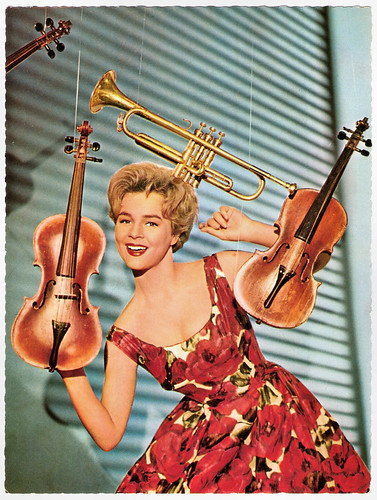
Big Dutch postcard by Gebr. Spanjersberg N.V., Rotterdam. Cornelia Froboess.
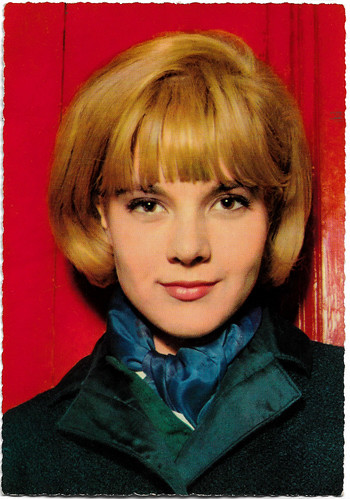
West-German postcard by Krüger, no. 902/267 Photo: Neuvecelle. Sylvie Vartan.
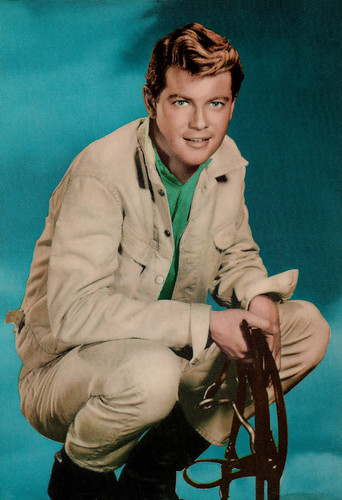
Spanish postcard by C y A, no. 29. Photo: Warner Bros. Caption: Troy Donahue, co-stars in Warner Bros. Palm Springs Weekend.

German postcard by Krüger, no. 902/145. Photo: UFA. Elvis Presley in Blue Hawaii (Norman Taurog, 1961) with Pamela Austin, Joan Blackman Jenny Maxwell, Darlene Tompkins, and Nancy Walters.
Sources: Frank Hoffmann (Survey of American Popular Music), Paul McGuinness (Udiscovermusic), and Wikipedia.
This post was last updated on 12 January 2025.
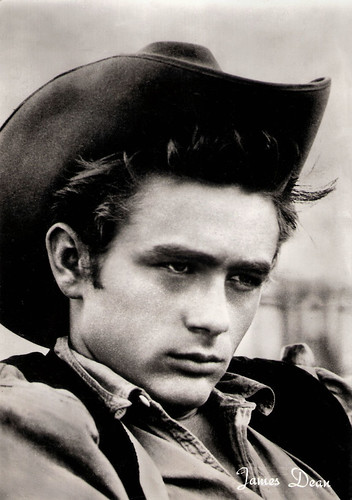



2 comments:
Really enjoyed this one so much I posted the link at my blog. I was a big fan of Horst---being first introduced to him in the the Cagney film 1,2,3---loved him in The Magnificent Seven---and of course Fanny-----so talented.
And Horst was so handsome. Thanks for sharing our post on your blog!
Post a Comment